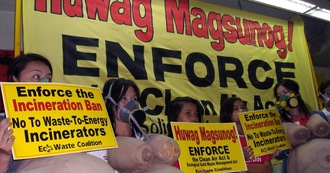-
STOP CEBU's La Vie in the Sky Skylanterns Release"I would like us all to make a serious commitment to respect and protect creation, to be attentive to every person, to counter the culture of waste and disposable, to promote a culture of solidarity and of encounter. Thank you." - Pope Francis. General Audience June 5th, 2013 "This same “use and throw away” logic generates so much waste, because of the disordered desire to consume more than what is really necessary." - Pope Francis (Laudato Si, 123) This activity is INTENTIONAL VIOLATION of Republic Act 9003 - mismanagement and improper segregation of waste. Likewise, of the fisheries code and wildlife act, among others. 1. What goes up must come down, and farmers in particular have become increasingly concerned that livestock might swallow a lantern's wire or bamboo frame, or, even worse, that fires might break out in hay barns. Elsewhere, coastguards say lanterns, which can travel for several kilometres and to an altitude of 1,000m before the candle burns out, are routinely mistaken for distress flares. A handful of east Asian countries, such as Vietnam, Malaysia and Thailand, have already introduced bans, particularly in the lead up to major festivals. (https://www.theguardian.com/environment/2010/feb/02/sky-lanterns-danger-farm-animals) 2. Countries like Argentina, Austria, Australia, Brazil, Chile, Colombia, Costa Rica, New Zealand, Spain, Germany, and parts of Canada and the USA have actually already banned the release of sky lanterns. (http://www.wheninmanila.com/why-we-should-not-release-balloons-skylanterns/). 3. However, the worst part of the fallout from the activity is the impact on local fauna. Reports of animals dying painfully, typically strangled by old lanterns' wires or suffocated by undecomposed paper, are frequent during this time of year. Some visitors are no doubt already aware of this, particularly following the high-profile death of an owl in the U.K. a few years ago. The bird was found suffocated and partly burnt inside the remains of a lantern... Humans are also at risk. The light emitted by lanterns sent en masse at night has been proven to be disruptive to aircraft pilots. As such, some countries like Malaysia have banned the use of sky lanterns in and around certain cities in order to prevent fatal accidents. (http://www.chinapost.com.tw/editorial/taiwan-issues/2017/02/10/491229/pingxis-sky.htm) 4. Though they are undoubtedly beautiful, even the biodegradable lanterns can be incredibly harmful to both the environment and wildlife. Sky lantern litter takes quite some time to decompose, and the wire frames have been known to strangle and maim wild animals and livestock. They also pose a significant fire hazard. Not only have they caused multiple wildfires, a sky lantern was also responsible for a massive fire at the Smethwick Recycling Plant in West Midlands, England. (http://earth911.com/living-well-being/events-entertainement/environmental-impact-traditions/) 5. With Save Philippine Seas, know more about the ills and harms of sky lantern releases here: https://www.facebook.com/pg/savephilippineseas/photos/?tab=album&album_id=13182383849323671,150 of 2,000 SignaturesCreated by Living Laudato Si' Philippines

-
STOP COVE MANILA'S BALLOON DROPIt is unsustainable, wasteful and ecologically apathetic. Cove Manila said that the balloon drop will be done indoors and will follow waste disposal guidelines but the activity in itself contradicts the basic principles of environmental sustainability. 1. All of these balloons, if not recycled, will end up as waste in landfills and other areas which will harm wildlife, marine and terrestrial ecosystems and even clog sewage systems, among others. 2. The Philippines is 3rd in the world dumping wastes into the oceans. Don't add more. 3. There are environment-friendly alternatives, read here: https://balloonsblow.org/environmentally-friendly-alternatives. Need more reference? Download Save Philippine Seas Defying Gravity Toolkit at http://www.savephilippineseas.org/toolkits Let's look reflect on the words of econetizen Grayson Gil Lidon Yañez: "Dear Cove Manila, we know this event sounds like a blast in time for the new year but we’ve never been this challenged with plastic pollution than ever before. 130,000 is a massive number of balloons and trash that could flow to the oceans in due time. We hope you reconsider your choice of material for your celebration and we would gladly help you think of more environmentally-friendly yet still fun ways to usher in the new year... We understand that it will be done indoors and that you comply with waste disposal rules. But wouldn’t it be wiser, more cost-efficient, and sustainable to prevent at source? And by this we mean completely refraining from using balloons instead. It’s 130,000 plastic/rubber balloons we are talking about here — at a single event. Chances are it will still be dumped in sites or eventually end up in the oceans. Hope you will still reconsider and help us take action in taking care of our environment. There are many ways to celebrate and have fun, but not at the expense of the environment. And again, we will gladly help you think of other ways..." Econetizen Edgar Alan Zeta-Yap adds: "Despite repeated calls by netizens this past week to find an eco-friendly alternative to their extremely wasteful event, Cove Manila of Okada Manila continues to defend their ”record-breaking” release of 130,000 balloons at their New Year’s Eve party, sponsored by Hennessy and Belvedere Vodka. Justifying that the world’s largest balloon drop will be held indoors and that proper waste disposal will be followed, they totally miss the point as the country — and the entire planet — suffers from plastic pollution on a monumental scale as it is. More than 80% of plastic waste in the country is mismanaged, and often ends up in the ocean. And the Philippines is already the world’s third largest contributor to plastic pollution in the ocean."72,226 of 130,000 SignaturesCreated by Rodne Galicha
-
No To Petron Depot in Pongol Balogo Pasacao Camarines SurBalogo Pasacao Camarines Sur is known as one of the key player of tourism in "the summer capital of camarines sur" Pasacao, knowing that this is a tourist area putting up an oil depot that covers 2.6hctrs of land and a massive port of 800meters that could handle both inter island and international vessels would not only stop the tourism but would also Destruct the marine life, Farmers life, and the crystal clear waters of these beaches.181 of 200 SignaturesCreated by Jeth Ablaneda
-
ONE MILLION SIGNATURES FOR THE FUTURE: No to Manila Bay Reclamation, No to Bulacan AerotropolisSalus populi est suprema lex! The welfare of the people is the supreme law ! This is the moment for the one million signatures for the defense of our ecosystems and habitats! One million voice to say NO to Manila Bay Reclamation, NO to Bulacan Aerotropolis and NO to worse flooding! YES to pro-environment and pro-development model that upholds quality life for the greater majority! The NAIA lockdown in August this year, however an isolated incident, was played up and what ensued were seemingly orchestrated efforts from government and business interest groups to speed up the final approval of San Miguel Corporation’s New Manila International Airport. Despite prospects for NAIA rehabilitation, and the expansion of the Clark International Airport to address air gateway woes, however at less cost and less toll for the environment, in all indications, in as far as the Bulacan Provincial Government and Bulakan town’s local authorities are concerned, it’s all systems go for the proposed P735B worth Aerotropolis in Taliptip, Bulakan, Bulacan. The game changer, as tagged by one of SMC bigwigs, the Bulacan Aerotropolis is a multimodal facility, with a mega airport, seaport, industrial and commercial complex, residential and entertainment hubs, which shall sit on a 2500 hectare expanse on the coastal area of Taliptip. Weeks before it was approved by the NEDA Board chaired by President Duterte in April 2018, hundreds of mangrove trees have been cleared in “SMC-acquired” coastal waters, allegedly initiated by SMC men. Interestingly, a DENR representative revealed, the whole of Taliptip coastal side is classified as timberland, is non-disposable and inalienable, and may only be used for aquaculture. Monsoon surges and heavy rains in August have submerged surrounding communities and towns for a number of days. “Wala pa ang airport nyan”, as observed by most of the affected residents. While the proponent obscures reclamation as the base for the implementation of its project, a San Miguel Holdings Corporation’s executive disclosed that recognizing their host province as perennially flood-prone, they are ready to spend for flood mitigating infrastructures as spillways and dams, “if necessary”. Spillways and dams? For whose gain and whose loss ultimately? Development for whom, and at what expense? Though yet under procedural process, displacement of hundreds of families in Taliptip’s influence communities is impending, and nothing is certain but the mere “promise” of a relocation site. Scientists assert reclamation’s disastrous impact on the environment compounded with social and cultural implications: deforestation, loss of biodiversity, food insecurity, prolonged massive flooding, liquefaction and soil subsidence, storm and monsoon surges along coastal villages ,among others, adversely affecting the vulnerable sectors of society. As advocates for the defense of livelihood, communities and the environment, we are urgently called to band together to form the broadest network to oppose this gigantic profit-driven development project! Let us come forward by the thousands of voices, by a million hands and feet marching to signify our collective stand. Tell the government we are for development, so long as it includes us. Please affix your signature below and make history!433 of 500 SignaturesCreated by Giya Clemente
-
Stop Killing Trees in TaguigWhen are we going to learn and value the importance of nature? These trees give us shade, protection from flood and help us clean the air in this traffic prone area. Global warming is real and we are already experiencing its dangerous impacts. What will happen if all these trees are gone? Will the road widening really solve traffic? I bet not. What is definitely going to happen is that everyday we will be forced to breath in polluted air as we pass through Lawton Ave. There will no more trees to cover and protect us during the scorching heat of summer. These trees are already there even before most of us were born. Please stop Killing them because losing them will slowly kill us too. The wrong things that we are doing with Mother Nature will come back to us tenfold.282 of 300 SignaturesCreated by Silver Dimaampao
-
No to Coal-fired Power Plant in La Union, the Surfing Capital of the North!La Union is under threat: the construction of a 670-megawatt coal-fired power plant (CFPP) is expected to commence this year, in the historic town of Luna, which is known for its natural geophysical and cultural assets of high ecological, livelihood and touristic value. Within the 2 to 30 aerial-kilometer radius of the proposed coal-fired plant are the towns of Balaoan, known for its bountiful corn harvests and biodiverse coral gardens; of San Juan and Bacnotan, the main surfing areas; and of San Gabriel, home to Tangadan Falls (the most popular falls in Northwest Luzon) and Lon-oy Springs (a major water supply source of the City of San Fernando and suburbs). All of these will be degraded and eventually destroyed once the CFPP starts spewing toxic chemicals. Moreover, the water heated by the plant’s cooling system will blanch and damage supersensitive corals within the Darigayos Cove, known for its rich marine ecosystem (the source of livelihood of thousands of fisherfolks) and heritage structures along its white beach. We APPEAL to President Rodrigo Duterte, DENR Secretary Roy Cimatu, DOT Secretary Bernadette Romulo-Puyat, Sen. Cynthia Villar (Environment Committee), Sen. Sherwin Gatchalian (Energy Committee), DA Secretary Manny Pinol, Congressman Pablo Ortega, Congresswoman Sandra Eriguel, Governor Francisco Emmanuel Ortega III, Vice Gov. Aureo Nisce, Mayor Victor Marron and Vice Mayor Romeo Resureccion to: 1. Deny GLEDC’s application for an environmental compliance certificate (ECC) including other permits to construct and operate the CFPP. The proponents used deceit, bribery and strong-arm tactics to suppress opposition to their plan and did not fully comply with the required ECC processes as it only consulted residents in the five (5) barangays in and around the proposed 41-hectare site and excluded/ignored other towns and barangays within the plant’s immediate impact area as shown by the NO2 modelling exercise done by its own environmental consultants. Likewise, the Environmental Impact Assessment done by GLEDC’s consultants was also found to be technically deficient and misleading by other technical experts. 2. Pursue an alternative development agenda that is consistent with the Agri-Tourism Development Strategy of the Provincial Government of La Union being espoused by no less than Governor Pacoy Ortega. The proposed site and the nearby Darigayos Cove and Mt Kangisitan can instead be developed as an ecotourism zone linked with other touristic attractions of La Union. 3. Identify and develop renewable energy sources to augment the country’s power supply. As La Union has a very high photovoltaic potential, more solar farms similar to those in Batangas should be built as soon as possible.6,703 of 7,000 SignaturesCreated by Koalisyon Isalbar ti Pintas ti La Union (Coalition to Save the Beauty of La Union)

-
STOP NATIONAL ROAD CONSTRUCTION AT MT. GUITING-GUITING NATURAL PARK (SIBUYAN ISLAND, ROMBLON)Remember that Mt. Guiting-guiting is Sibuyanon’s remaining terrestrial life-support system. If we attempt to destruct its ecological balance without proper scientific and sociological bases under the principles of sustainable development, we will all suffer the consequences. At the heart of Sibuyan Island is the Mt Guiting-Guiting Natural Park (MGGNP). It is the only remaining mountain in the Philippines with relatively intact habitats along its entire elevational gradient. Mt. Guiting-Guiting’s plant and mammal biodiversity is amongst the richest in the world (Heaney and Regalado 1998, Goodman and Ingle 1997, DENR 1997) Be it known that Bayay Sibuyanon and those who seek the stoppage and investigation of this project are not against development but shall continue to promote and adhere to the targets and indicators of Sustainable Development Goals (SDGs). Sustainable development and precautionary principles must always be considered in implementing projects in ecologically sensitive and disaster prone areas. The ‘Priority Sites for Conservation in the Philippines: Key Biodiversity Areas’ document by the Protected Areas and Wildlife Bureau (PAWB), now BMB, of the Department of Environment and Natural Resources (DENR) exposes that there are one critically endangered, four endangered, and eight vulnerable species of biodiversity in Mt. Guiting-guiting Natural Park, which includes the endangered Philippine tube-nosed fruit bat, Nyctimene rabori, and a vulnerable Sibuyan pitcher plant, Nepenthes sibuyanensis. The project is not included in the Mt. Guiting-guiting Natural Park Management Plan. Almost every year, new biological species are being discovered. In 2008, a new species of stick insect has been discovered, the Pharnacia magdiwang. In 2010, a new species of shrew has been documented, Crocidura ninoyi. Gekko coi or Leonard’s Forest Gecko, named after famous taxonomist Leonardo Co, was known in 2011. And in 2012, a new owl species has been found, Ninox hilippensis spilonota; in 2014 a pitcher plant named after a Sibuyanon slain environmentalist Armin Marin, Nepenthes armin. In the same year, a rare endemic species of a tree skink Lipinia vulcania was recorded and a new species of lizard called Pseudogekko isapa sp. The Department of Environment and Natural Resources describes Sibuyan Island having "relatively rich biodiversity": "There are approximately 700 vascular plant species, including 54 species that are endemic to the island. These include Nepenthes sibuyanensis J Nerz (Sibuyan Pitcher Plant); Heterospathe sibuyanensis Becc. (Bil-is), Pinanga sibuyanensis Becc. (Tibañgan), and Orania palindan var. sibuyanensis, a wild palm; Alpinia sibuyanensis, Phyllanthus sibuyanensis, Cyathea sibuyanensis Copel. (Tree Fern); Agamyla sibuyanensis Hilliard & BL Burtt (Sibuyan lipstick plant); Myrmephytum beccarii Elmer (Sibuyan ant plant); Begonia gitingensis Elmer (Guiting-guiting begonia). Of the 700 plant species in the Island, 180 species can only be found in the Philippine archipelago. There are numerous endemic species in Mt. Guiting-Guiting that occupy specific habitats. These are found mostly in primary forest with elevation of 100 meters or higher (Madulid, Domingo, 1997). The endemic species found in the protected area are as follows: • Sararanga philippinensis grows gregariously and form distinct clumps in Peat swamp forest along riverine/riparian forest at low altitudes. • Heterospathe sibuyanensis and Ardisia sibuyanensis located in primary forest at medium altitudes; and • Nepenthes merrillii and Alpinia sibuyanensis most of these are found in primary forest between 100 and higher elevations. A total of 130 species of birds have been recorded in Sibuyan, of which 102 are either known or presumed to be breeding residents. These are: Cinnamon Bittern-Lapay (Ixobrychus cinnamomeus), Celestial Monarch (Hyphothymis coelestis), Striated Grassbird (Megalurus palustris forbesi), Rufous –lored Kingfisher (Halcyon winchelli nesydrionetes), Pygmy Swiftlet (Collocalia troglodytes), and Philippine Hawk-Eagle (Spizaetus philippensis). Sibuyan is also home to nine (9) native non-flying terrestrial mammal species, four (4) of which are endemic rodents (Goodman and Ingle, 1993). This are: Greater Sibuyan forest mouse (Apomys sp. B), Lesser Sibuyan forest mouse (Apomys sp. C), Sibuyan striped shrew-rat (Chrotomys sp. A), and Sibuyan giant moss mouse (Tarsomys sp. A) . Out of nine fruit bat species found in the island, only one (1) species, Sibuyan Pygmy fruit bat (Haplonycteris sp. A) is endemic (Goodman & Ingle, 1993). Dugongs (Dugong dugong) have also been sighted within the municipal waters and dolphins and whales are also expected to be visiting the area. There are nine (9) recorded species of lizards and geckoes two (2) which are classified as endemic and rare. Gekko romblon, the Romblon narrow-disked Gecko, appears to be limited to Tablas and Sibuyan Island."586 of 600 SignaturesCreated by Bayay Sibuyanon Inc. Romblon, Philippines

-
No to Coal in BoholAlarmed that there are sectors in the Provincial Government along with investors and power providers who are poised to endorse a backward idea of a coal-fired power plant in the island, we demand that our leaders to lead us in achieving Bohol’s Goals that include, among others, Environmental Protection and Management; and, Responsive, transparent and accountable governance. Drawing from our earlier manifesto, we echo the call, this time, taking a firm stand against whatever plans and machinations there might be to utilize coal in generating power within our province. We have united behind the following arguments: 1. THAT COAL IS DIRTY AND DEADLY. Coal damages both people and planet. Existing and proposed coal power plants in the Philippines can cause up to 2,410 premature deaths annually according to a 2015 Harvard study. Coal burning emits substances which contribute to smog, haze, lung disease, and respiratory illnesses; as well as neurological and developmental damage in humans and other animals (US Energy Information Administration, 2017). Coal mining contributes to soil erosion, water pollution and loss of biodiversity. It is directly linked with climate change as it is responsible for 46% of carbon dioxide emissions worldwide, inducing natural disasters. 2. THAT COAL IS COSTLY. While there is still a popular perception that coal is sold cheaply, a research by the International Institute for Sustainable Development (IISD) revealed that coal use actually brings with it additional costs that are not traditionally taken into account such as: (1) Subsidies to coal producers; (2) Air pollution estimated to cause more than 6,000 global deaths annually; and, (3) Greenhouse Gas emissions that undermine targets under the Paris Agreement on Climate. If we monetize these impacts the total cost of coal is estimated to be around USD 11 cents per kilowatt hour (kWh), more than double the cost of competing renewable energy based on recent renewable auction results. 3. THAT GLOBALLY COAL IS NO LONGER A VIABLE OPTION. The recent falls in solar Photo Voltaic prices have led India to cancel new coal capacity, in addition to rising concern about the impacts of coal use on air pollution. In China, this concern led to a moratorium on new coal plants in 28 out of 31 provinces. With the tide turning against coal across the world, there is real concern that investments made today could soon be impossible to operate on environmental, public health and cost grounds, leaving a legacy of stranded power stations as the last monuments to the age of coal. (IISD, 2017) WE REJECT the proposal or plan of private or government investors in establishing a coal-power plant in the province of Bohol because it is tantamount to a violation of the existing laws and commitment for the Boholano people; WE DECLARE that renewable energy is the way forward. A 2013 World Wide Fund for Nature (WWF) report said that in 2011, at least 384 renewable energy service contracts were awaiting approval from the Department of Energy, equalling to 6,046 MW of generation capacity. Currently, there are 13 operational coal-fired power plants with a combined installed capacity of 4.937 MW; WE STRONGLY SUPPORT the development of renewable energy sources as the way forward for our beloved Bohol that claims to have ecological and cultural tourism as its main path for sustainable development being one of its primary economic drivers. WE ENJOIN our fellow Boholanos and residents to join us in this worthy cause to save our environment from this threat of destruction for our sake and the future generation. WE DEMAND as citizens and voters that the Sanggunian Panlungsod of Tagbilaran City and the Sangguniang Panlalawigan of Bohol shall recognize the negative impact of coal-based power generation and the need to shift to renewable energy sources by passing Resolutions to support calls for “a moratorium on the establishment of carbon-intensive and fossil-based technologies”; and interpose its objection on any proposed coal-fired project within our province; WE ALSO URGE on the Office of the Secretary of the Department of Environment and Natural Resources and the Office of the Secretary of the Department of Energy to deny any applications for coal-fired and other fossil-based power plants within Bohol; and implement the mandate for the development and use of renewable, sustainable energy sources and technologies.863 of 1,000 SignaturesCreated by Liza Macalandag
-
Uphold the Philippine Ban on Waste IncinerationIncineration, including so-called "waste-to-energy" (WTE) incineration facilities (i.e. burning waste to produce electricity), is neither a good way to manage waste nor to produce electricity. In fact, it is proven to be the most expensive, most polluting, most energy intensive and most inefficient way to manage waste and generate electricity: 1. Incineration is a major source of cancerous dioxins and furans, which are regulated under an international treaty, the Stockholm Convention on Persistent Organic Pollutants; and 2. It is also the most expensive way to produce electricity--WTE facilities cost more to construct and operate than coal or nuclear plants. But the government--through Congress and the Department of Environment and Natural Resources (DENR)--are aggressively promoting WTE incineration thinking it will magically solve the country's waste problems. House Bill 2286 seeks to repeal the incineration ban in the Philippine Clean Air Act (RA 8749) and amend the Ecological Solid Waste Management Act (RA 9003) in order to allow the entry of WTE incineration technologies in the Philippines. And the DENR is even paving the way for waste incineration, instead of of doing their duty to protect the environment. The Clean Air Act guarantees every Filipino’s right to breathe clean air and right to a healthy environment. The ban on incineration supports this. Waste incineration aside from being a major source of cancer-causing emissions, also produces particulate matter, which is identified as a leading cause of premature deaths. The bill also undermines the country’s landmark waste law, RA 9003, which calls for an ecological approach to waste management. Incinerators, and WTE incineration facilities threaten human health, pollute our air, land and water, harm our economies, contribute significantly to global warming, and fuel an unsustainable system of consumption and wasting. They have no place in an ecological waste management system, and in today's emerging circular economy. Congress and the DENR must realize that incineration is not a feasible waste treatment option. Instead, they must work toward real solutions and adopt the Zero Waste approach to waste and resource management. This can start with the strict implementation of RA 9003 which does not only save money, but also creates jobs, improves public health and mitigates climate change.139 of 200 SignaturesCreated by No Burn Pilipinas Alliance
-
Peoples Petition for Sustainable and Ecological Food System in the Philippines.We are experiencing a food emergency with hunger in the Philippines categorized as a “serious problem” in the 2015 Global Hunger Index. In the past 15 years (1999-2014), the number of Filipino families who rated themselves as hungry rose from 8.3% to 18.3% based on the Social Weather Station’s (SWS) self-rated hunger survey. The SWS survey also revealed that 13.4% of families suffer from involuntary hunger in 2015. The victims of hunger are mainly children and women with where 20% of children below 5 years old are underweight, 30% are underheight, and 8% are wasted; while 31% of adults 20 years old and above are overweight or obese mainly due to increasing consumption of unhealthy food. There is minimal support for building on-farm biodiversity and promoting access to diverse diets to address nutrition security and build farm resilience against the impacts of climate change. Our farms, especially those under industrial production, depletes our soils and poisons our water and air with extensive use of chemical fertilizers and pesticides. Ironically endangering the very environment that supports food production. Our trade rules and incentive measures favor more corporate food production, whereas more than 80% of our food is still produced by small holder Filipino farmers, who remain poor, hungry and malnourished. While the Philippine Constitution and laws is replete with provisions on food security, there is an urgent need for greater coherence, convergence and synergy on the various programs of government on food which are presently governed under different departments and agencies. Our Constitution explicitly statesd that the State shall defend the right of children to assistance, including proper care and nutrition. We have yet to realize this Constitutional rights owing to a lack of policy framework that advances the right of peoples to healthy and culturally appropriate food produced through ecologically sound and sustainable methods, and the Filipinos’ right to define our own food and agriculture systems. The essence of food security and sovereignty is the total and full development of every Filipino living a life with dignity. Join us! Together, let us advance as sustainable/ecological food system for all Filipinos.208 of 300 SignaturesCreated by Peoples Food Movement
-
Stop Legazpi City Flying Lantern Release1. What goes up must come down, and farmers in particular have become increasingly concerned that livestock might swallow a lantern's wire or bamboo frame, or, even worse, that fires might break out in hay barns. Elsewhere, coastguards say lanterns, which can travel for several kilometres and to an altitude of 1,000m before the candle burns out, are routinely mistaken for distress flares. A handful of east Asian countries, such as Vietnam, Malaysia and Thailand, have already introduced bans, particularly in the lead up to major festivals. (https://www.theguardian.com/environment/2010/feb/02/sky-lanterns-danger-farm-animals) 2. Countries like Argentina, Austria, Australia, Brazil, Chile, Colombia, Costa Rica, New Zealand, Spain, Germany, and parts of Canada and the USA have actually already banned the release of sky lanterns. (http://www.wheninmanila.com/why-we-should-not-release-balloons-skylanterns/). 3. However, the worst part of the fallout from the activity is the impact on local fauna. Reports of animals dying painfully, typically strangled by old lanterns' wires or suffocated by undecomposed paper, are frequent during this time of year. Some visitors are no doubt already aware of this, particularly following the high-profile death of an owl in the U.K. a few years ago. The bird was found suffocated and partly burnt inside the remains of a lantern... Humans are also at risk. The light emitted by lanterns sent en masse at night has been proven to be disruptive to aircraft pilots. As such, some countries like Malaysia have banned the use of sky lanterns in and around certain cities in order to prevent fatal accidents. (http://www.chinapost.com.tw/editorial/taiwan-issues/2017/02/10/491229/pingxis-sky.htm) 4. Though they are undoubtedly beautiful, even the biodegradable lanterns can be incredibly harmful to both the environment and wildlife. Sky lantern litter takes quite some time to decompose, and the wire frames have been known to strangle and maim wild animals and livestock. They also pose a significant fire hazard. Not only have they caused multiple wildfires, a sky lantern was also responsible for a massive fire at the Smethwick Recycling Plant in West Midlands, England. (http://earth911.com/living-well-being/events-entertainement/environmental-impact-traditions/) 5. With Save Philippine Seas, know more about the ills and harms of sky lantern releases here: https://www.facebook.com/pg/savephilippineseas/photos/?tab=album&album_id=1318238384932367787 of 800 SignaturesCreated by Rodne Galicha
-
Everybody has a Right to Compassionate, Plant-based/Vegan Food, Give us Access to it!There is a growing number of people all over the world, and in the Philippines who are shifting to a vegan diet and lifestyle. It is a conscious choice to show love and respect for animals and Mother Earth, and to care for one's own health and well-being. People like these should not be marginalized by having practically nothing to choose from in school, office, and hospital canteens, restaurants, hotels, and other food establishments. There are a number of vegan groups on Facebook in the Philippines, such as Vegan Philippines, Manila Vegans, Vegans of Manila, among many others. These are proof that there is a growing interest in a vegan diet in the country. The members of these groups are vegans, transitioning, or vegan-curious. Aside from the people who are in vegan groups, there are countless others who prefer healthier, more ethical, and more environment-friendly food choices. There are so many reasons why a vegan diet is becoming the food choice of many: 1. COVID-19 is one of the many zoonotic diseases that have caused a lot of death and suffering in the Philippines and the rest of the world. There are also other emerging diseases from animals that could cause another pandemic such as various strains of the swine flu virus and the bubonic plague. There is no better time than now to support and promote plant-based/vegan food in the country to build health and immunity, and to prevent another pandemic from emerging. 2. Compassionate/Vegan food is an ethical choice as it does not use any animal ingredients that cause needless suffering and death to animals. Animals are sentient beings that should not suffer and die for people's taste buds. Everyone could thrive on a balanced vegan diet. There is no need to kill animals for food. See the documentary Earthlings for more information. 3. Vegan food is better for the climate. With worsening climate change, shifting to vegan food drastically reduces one's carbon footprint. A meat-based diet has been found to generate more carbon pollution than the entire transport sector. An Oxford University study found that meat-based diets result in 7.2 kg carbon emissions a day, while only 2.9 kg for a vegan diet. Recently, the DENR started promoting a plant-based to help address climate change. Also, see the documentary Cowspiracy for a better understanding of this. 4. Vegan food is kinder to Mother Earth. With the antibiotic-laden animal waste being generated by the poultry and livestock industry, so much soil and water are being polluted every single day. Livestock is fed with corn, soybeans, and grains, which require a huge amount of fertilizers and pesticides. There is also an inefficient conversion of calories of crops for food converted to animal feeds. More people would be fed by directly using grains for food than if they were converted to animal feeds. 5. Vegan food is healthier. Whole foods, fresh fruits, and vegetables are more alkaline and thus prevent many types of illnesses. Studies have shown that blood from vegans fight off cancer cells. There are also numerous studies showing vegans have a lower risk of cancer, as well as lower rates of diet-related diseases such as obesity, diabetes, and hypertension. Canada has revised their dietary guidelines with much emphasis on plant-based food. For more information on health benefits of a plant-based diet, see the documentary What the Health. People who make an effort to make conscious choices for animals, for their health, and for the planet should be provided access to these kinds of food. By providing compassionate food choices, it could also make businesses thrive. Owners of vegan restaurants and shops claim most of their customers are not even vegan but vegan-curious, who are more than happy to try healthier, more earth-friendly, and ethical food choices. This means that given alternatives, more people would start to choose better. Even non-vegans deserve to have a choice when they want to try healthier, more ethical alternatives. Vegans would like to alleviate the needless suffering and death of animals and in the process also protect the earth, the climate, and themselves. Why should hotels, restaurants, canteens, and grocers not provide vegan choices to them? In fact, everybody should have access to vegan food. The future is vegan, let us create it now by supporting and promoting vegan food.429 of 500 SignaturesCreated by Shiela R Castillo













